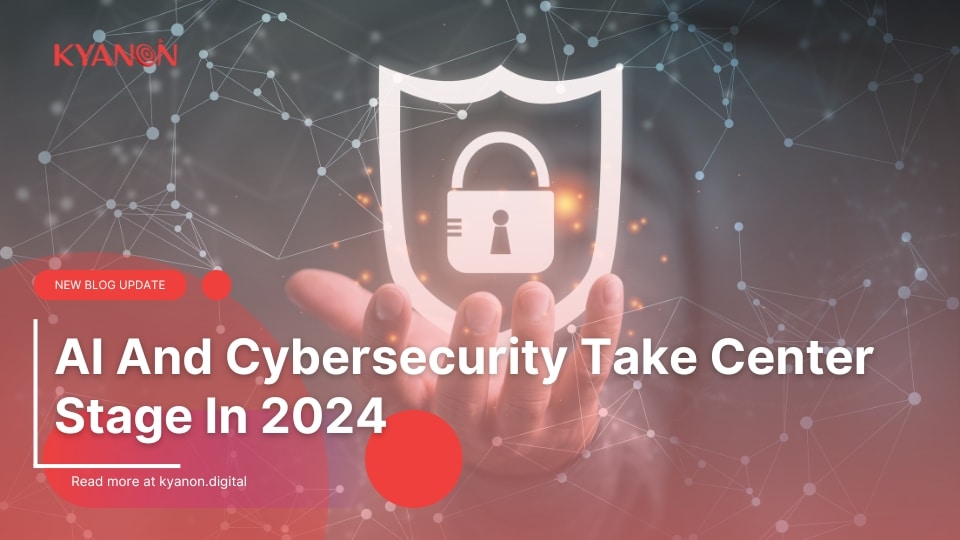The exponential growth of artificial intelligence (AI) has permeated diverse fields, with cybersecurity experiencing a paradigm shift due to its integration. In our hyper-connected world, the digital landscape undergoes rapid transformations. Consequently, the synergy between AI and cybersecurity ushers in a new era. AI is no longer a peripheral concept; it occupies a pivotal position within any organization’s cyber defense strategy, fueling advancements across this critical domain.
Let’s dive deeper into the interesting topic AI and Cybersecurity take center stage in 2024 with Kyanon Digital.

1. AI’s Empowering Alliance with Cybersecurity
As per Statista’s findings, the market value of artificial intelligence (AI) in cybersecurity is projected to surge from $10 billion in 2020 to $46.3 billion by 2027, showing a robust compound annual growth rate (CAGR) of 25.51%. The corporate realm increasingly relies on AI to fortify cyber defenses, with 69% of businesses prioritizing swift responses to cyber attacks.
By 2024, AI is poised to assume an even greater role in cybersecurity, providing preemptive measures against evolving threats. This year, several trends are expected to persist and expand, including:
- Predictive analytics: Utilizing AI, future cyber threats can be anticipated by analyzing historical data and current trends, enabling proactive measures to be taken in advance.
- Behavioral analytics: AI can establish norms for user behavior based on insights, swiftly flagging any deviations as potential security breaches.
- Generative AI: The advent of generative AI, such as ChatGPT and Bing, is expected to shape cybersecurity strategies and is currently undergoing research and development.
- Automated Incident Response: AI technologies excel in swiftly identifying and addressing security issues, surpassing human capabilities in speed and effectiveness.
- Adaptive Authentication and Access Controls: In 2024, AI-driven analysis of user behavior will enable the dynamic adjustment of authentication requirements, enhancing security while maintaining user experience through automation.
- Collaborative Threat Intelligence Sharing: AI will streamline the analysis and sharing of threat intelligence, fostering collaborative efforts to counter cyber threats.
Moreover, according to TrendMicro, Generative AI can enhance the efficiency of cybersecurity teams by facilitating precise and swift search queries, simplifying complex scripts and instructions, and providing clear explanations of alerts, thus enabling non-experts in search languages to work faster and more productively. Acting as a “force multiplier,” it enables instant implementation of security response plans during incidents.
Furthermore, AI-driven automation can alleviate the burden of incident reporting, particularly for regulated businesses. This encompasses managing ticketing and reporting processes, translating reports into multiple languages, and rapidly extracting actionable insights from documents.

The integration of cybersecurity and AI presents its own set of challenges, notably the susceptibility of AI systems to manipulation by malicious actors.
GlobalData forecasts a growing prevalence of AI in cybersecurity, serving both defensive and offensive purposes. By 2024, cybercriminals are expected to continue exploiting social engineering tactics for financial gain, capitalizing on the human element as a common vulnerability across all sectors. Advancements in AI and analytics provide cybercriminals with new tools to exploit these human weaknesses.
Moreover, Bain & Company highlights the potential for hackers to leverage generative AI, equipping them with capabilities comparable to defenders. This technology may be utilized by less proficient attackers to craft more convincing phishing emails or create realistic deep fake content, such as photos, audio, and emails. Additionally, malicious actors can easily modify known attack code using generative AI to evade detection.
Hence, while AI offers numerous advantages, it also entails significant responsibilities. Nevertheless, when combined with adaptive strategies, a security-conscious organizational culture, and zero-trust security frameworks, generative AI empowers businesses to establish a strong and proactive defense.
To harness the immense potential of AI while mitigating associated risks, businesses must prioritize secure solutions and ethical practices. This involves continuously monitoring for threats, regularly updating systems, and providing comprehensive security training to staff. By implementing these measures, companies can ensure robust defenses against AI-related risks in 2024 and beyond.
Learn more about how we can assist you in effectively integrating AI and cybersecurity here.

3. New Regulations Expected for AI in Cybersecurity
Cybersecurity professionals emphasize the urgent need for regulatory and legal frameworks to intervene and set standards due to the rapid proliferation, easy accessibility, and widespread adoption of artificial intelligence. These regulations have garnered traction, prompting several nations to develop their own guidelines. The emerging regulatory frameworks must encompass considerations such as ethics, transparency (regarding the functioning of specific algorithms), privacy, and consistency.

4. Conclusion
Integrating AI into cybersecurity yields a stronger long-term security stance. With AI’s continuous learning and adaptation capabilities, security systems can evolve to match the ever-changing landscape of cyber threats. This fusion signifies more than just a fleeting trend; it heralds a transformative force poised to revolutionize governmental processes, ensuring enhanced transparency, efficacy, and resilience.
Nonetheless, business leaders must remain vigilant about AI’s ongoing impact on the threat landscape. It’s imperative to devise innovative strategies to bolster their company’s cybersecurity defenses and prioritize the development of a shared security responsibility model. Reach out to us for further insights!


